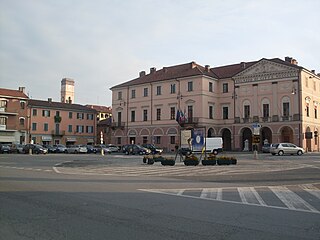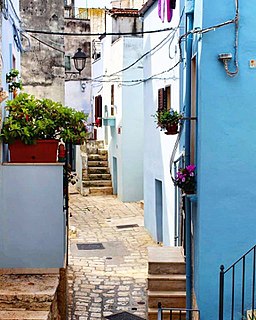
Aversa is a city and comune in the Province of Caserta in Campania, southern Italy, about 24 km north of Naples. It is the centre of an agricultural district, the Agro Aversano, producing wine and cheese. Aversa is also the main seat of the faculties of Architecture and Engineering of the Seconda università degli studi di Napoli. With a population of 52,974 (2017), it is the second city of the province after Caserta.

Formello is a town and comune in the Metropolitan City of Rome. It is located southwest of the Monti Sabatini, within the Regional Park of Veii. The communal territory is mostly composed by tuff, and is intensively cultivated.

Finale Ligure is a comune on the Gulf of Genoa in the Province of Savona in Liguria, Italy. It is considered part of the Italian Riviera.

Caserta is the capital of the province of Caserta in the Campania region of Italy. It is an important agricultural, commercial and industrial comune and city. Caserta is located on the edge of the Campanian plain at the foot of the Campanian Subapennine mountain range. The city is best known for the Royal Palace of Caserta.

Cosimo Fanzago was an Italian architect and sculptor, generally considered the greatest such artist of the Baroque period in Naples, Italy.

Racconigi is a town and comune in Piedmont, Italy. It is located in the province of Cuneo, 40 kilometres (25 mi) south of Turin, and 50 kilometres (31 mi) north of Cuneo by rail.

Saint Renatus is the name of a French and an Italian saint of the Catholic Church who is claimed to be the same person. There are different stories of two saints with by the name Renatus, who were later merged into a single one based on their described similarities and contemporaneity. Both are venerated in Italy and France. They were: Saint Renatus of Sorrento, and Saint Renatus of Angers. Part of their stories seem to be a legend, part incomplete and part deficient historically documented.

Montevarchi is a town and comune in the province of Arezzo, Tuscany, Italy.
San Gennaro Vesuviano is a comune and town located in the Metropolitan City of Naples, Campania, in southern Italy.
Marzano di Nola is a town and comune in the province of Avellino, Campania, Italy. This town is located in the Lauro Valley. It borders with Liveri, Pago, Lauro, Domicella and Visciano.

Casamassima is a town and comune of 19,786 inhabitants in the Metropolitan City of Bari, in Apulia, southern Italy. Is also called "The Blue Town". The town is located inland from the Italian coastline, thrives and is built on agriculture, primarily that of wine, olives and almond production. Founded around the seventh and eighth centuries, the village started as a Roman encampment, according to legend.

Cerisano is a town and comune in the province of Cosenza in the Calabria region of southern Italy.

Cadelbosco di Sopra is a town and comune in the province of Reggio Emilia in Emilia-Romagna, Italy.

Gradoli is a comune (municipality) in the Province of Viterbo in the Italian region Latium, located about 100 kilometres (62 mi) northwest of Rome and about 35 kilometres (22 mi) northwest of Viterbo.
Casaluce is a comune (municipality) in the Province of Caserta in the Italian region Campania, located about 20 kilometres (12 mi) north of Naples and about 13 kilometres (8 mi) southwest of Caserta.
Parete is a comune (municipality) in the Province of Caserta in the Italian region Campania, located about 15 kilometres (9 mi) northwest of Naples and about 20 kilometres (12 mi) southwest of Caserta. As of 31 December 2004, it had a population of 10,597 and an area of 5.7 square kilometres (2.2 sq mi).
Casalnuovo di Napoli is an Italian comune (municipality) in the Metropolitan City of Naples in the Italian region Campania, located about 13 kilometres northeast of Naples.
Palma Campania, known until 1863 as Palma di Nola, is a comune (municipality) in the Metropolitan City of Naples in the Italian region Campania, located about 25 km east of Naples.

The Diocese of Aversa is a Roman Catholic ecclesiastical territory in Campania, southern Italy, created in 1053. It is situated in the Terra di Lavoro (Liburia), seven miles north of Naples, and eight miles south of Capua. It is suffragan of the Archdiocese of Naples.
San Biagio is Roman Catholic church and monastery in the municipality of Aversa, province of Caserta, in the region of Campania, southern Italy.
















